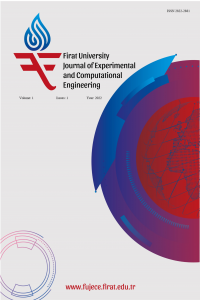Determination of water sensitivity of nanosilica added hot mix asphalt
Determination of water sensitivity of nanosilica added hot mix asphalt
Asphalt, Nanosilica Hot mix asphalt, Retained marshall stability, ITS,
___
- [1] El-Maaty Behiry AEA. “Laboratory evaluation of resistance to moisture damage in asphalt mixtures”. Ain Shams Engineering Journal, 4(3), 351-363, 2013.
- [2] Geçkil T, Aksağan Z, İnce CB. “Asfalt kaplamaların nem performansı üzerinde siyah karbonun etkisi”. Düzce Üniversitesi Bilim ve Teknoloji Dergisi, 9(5), 2101-2115, 2021.
- [3] Omar HA, Yusoff NIM, Mubaraki M, Ceylan H. “Effects of moisture damage on asphalt mixtures”. Journal of Traffic and Transportation Engineering (English Edition), 7(5), 600-628, 2020.
- [4] Geçkil T, Seloğlu M, İnce CB. “Sıcak karışım asfalt kaplamanın su hasarı direnci üzerinde RET katkısının etkisi”. Fırat Üniversitesi Mühendislik Bilimleri Dergisi, 33(2), 537-546, 2021.
- [5] Görkem Ç, Şengöz B. “Predicting stripping and moisture induced damage of asphalt concrete prepared with polymer modified bitumen and hydrated lime”. Construction and Building Materials, 23 (6), 2227–2236, 2009.
- [6] Özen H. “Rutting evaluation of hydrated lime and SBS modified asphalt mixtures for laboratory and field compacted samples”. Construction and Building Materials, 25 (2), 756–765, 2011
- [7] Petersen JC, Plancher HP, Harnsbergen M. “Lime treatment of asphalt to reduce age hardening and improve flow properties”. In: Proceedings AAPT, 56, 632-653, 1987.
- [8] Kennedy TW, Anagnos NJ. “Lime treatment of asphalt mixtures”, 4. Center for Transportation Research, Austin, United States, 20–28, 1983.
- [9] Epps J, Berger E, Anagnos JN, “Moisture sensitivity of asphalt pavements.” A National Seminar, California, United States, 117-177, 2003.
- [10] Kumar P, Chandra S, Bose S. “Strength characteristics of polymer modified mixes”. International Journal of Pavement Engineering, 7(1), 63–71, 2006.
- [11] Lazzara G, Milioto S. “Dispersions of nanosilica in biocompatible copolymers”. Polymer Degradation and Stability, 95 (4), 610–617, 2010.
- [12] Geçkil T, İnce CB, Özpınar ET. “Nanosilikanın bitümün kıvamı, viskozitesi ve mikroyapısına etkileri”. Konya Mühendislik Bilimleri Dergisi, 9(4), 845–857, 2021.
- [13] Shafabakhsh G, Akbari M, Bahrami H. “Evaluating the fatigue resistance of the innovative modified-reinforced composite asphalt mixture”. Advances in Civil Engineering, 1–10, 2020.
- [14] Shafabakhsh G, Motamedi M, Firouznia M, Isazadeh M. “Experimental investigation of the effect of asphalt binder modified with nanosilica on the rutting, fatigue and performance grade”. Petroleum Science and Technology, 37(13), 1495–1500, 2019.
- [15] Chen X, Liu S, Sun L. “Preparation and properties of emulsion asphalt modified by nanosilica/SBR composite”. China Rubber Industry, 54, 337-340, 2007.
- [16] Nazari H, Naderi K, Moghadas Nejad F. “Improving aging resistance and fatigue performance of asphalt binders using inorganic nanoparticles”. Construction and Building Materials, 170, 591–602, 2018.
- [17] Shafabakhsh G, Sadeghnejad M, Ebrahimnia R. “Fracture resistance of asphalt mixtures under mixed-mode I/II loading at low-temperature: without and with nano SiO2”. Construction and Building Materials, 266, 2021.
- [18] Yao H. “Rheological properties and chemical bonding of asphalt modified with nanosilica”. Journal of Materials in Civil Engineering, 25(11), 1619-1630, 2013.
- [19] Sun L, Xin X, Ren J. “Asphalt modification using nano-materials and polymers composite considering high and low temperature performance”. Construction and Building Materials,133, 358-366, 2017
- [20] Yusoff NIM. “Evaluation of fatigue behavior of asphalt layers containing nanosilica modified tack coat”. Advances in Materials Science and Engineering, 1-11. 2022.
- Başlangıç: 2022
- Yayıncı: Fırat Üniversitesi
Failure mechanism of a soil slope and stabilization method: a case study
Determination of water sensitivity of nanosilica added hot mix asphalt
Tacettin GEÇKİL, Ceren Beyza İNCE, Eda Tüzün ÖZPINAR
Classification of recyclable waste using deep learning architectures
Iredia Davis ERHUNMWUN, Mohammed Idaomi SALIU, Patrick Ejebheare AMIOLEMHEN
